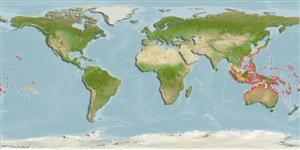Preferred temperature (Ref.
123201): 24.7 - 29.3, mean 28.3 °C (based on 1779 cells).
Phylogenetic diversity index (Ref.
82804): PD
50 = 0.5000 [Uniqueness, from 0.5 = low to 2.0 = high].
Bayesian length-weight: a=0.01995 (0.00906 - 0.04395), b=3.01 (2.83 - 3.19), in cm total length, based on all LWR estimates for this body shape (Ref.
93245).
Trophic level (Ref.
69278): 3.3 ±0.61 se; based on food items.
Resilience (Ref.
120179): High, minimum population doubling time less than 15 months (Preliminary K or Fecundity.).
Fishing Vulnerability (Ref.
59153): Low vulnerability (17 of 100).
Nutrients (Ref.
124155): Calcium = 146 [71, 260] mg/100g; Iron = 1.15 [0.64, 2.07] mg/100g; Protein = 18.7 [17.4, 19.9] %; Omega3 = 0.117 [0.060, 0.229] g/100g; Selenium = 44.1 [20.5, 94.6] μg/100g; VitaminA = 30.4 [7.8, 118.9] μg/100g; Zinc = 1.79 [1.12, 2.78] mg/100g (wet weight);
